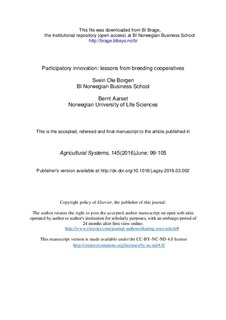Participatory innovation: lessons from breeding cooperatives
Journal article, Peer reviewed
Permanent lenke
http://hdl.handle.net/11250/2392721Utgivelsesdato
2016Metadata
Vis full innførselSamlinger
- Scientific articles [2217]
Originalversjon
Agricultural Systems, 145(2016)June: 99-105 http://dx.doi.org/10.1016/j.agsy.2016.03.002Sammendrag
Throughout the last decades, breeding in the plant sector, husbandry and aquaculture has come under the ownership control of multinational, investor-owned firms. Breeding in these sectors is risky business, but can be extremely profitable for the involved parties. Against high odds, a few breeding cooperatives have successfully increased their competitiveness in breeding by means of collectively organized innovation, here referred to as “Participatory Innovation”. Illustrated by data from two Norwegian breeding cooperatives, we explore conditions for success at intra- and inter-organizational levels. Two factors seem particularly important: (a) Members are leveraged as co-innovators and benefit from a multiplier-effect and (b) The breeding cooperatives have established strategic alliances with external R&D-actors (research institutions, gene banks etc.). These alliances provide inbound knowledge that enable commodification and commercialization of novel scientific insights at the cooperative level. We argue that “Participatory innovation” is a distinct conceptual mode of innovation, differing from more well-known meta-approaches like “Vertically Integrated Innovation”, “Open innovation” and “User innovation”.
Beskrivelse
This is the accepted, refereed and final manuscript to the article
